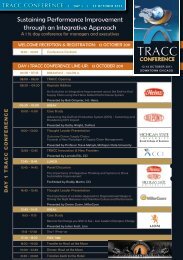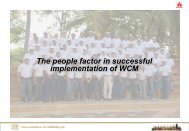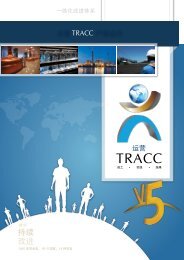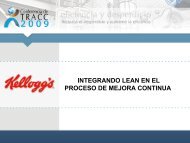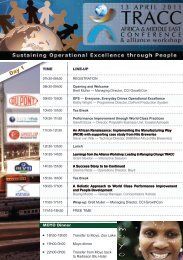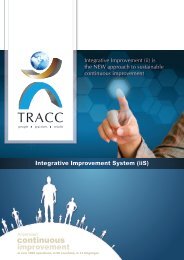Strategy - TRACC
Strategy - TRACC
Strategy - TRACC
Create successful ePaper yourself
Turn your PDF publications into a flip-book with our unique Google optimized e-Paper software.
<strong>Strategy</strong><br />
“Businesses are taking a refreshed view of supply chain strategy. The result is an end-to-end<br />
business capability that’s prioritised to sense and translate demand into the supply network.”<br />
WGLL Journal Volume 2 © CCI info@etracc.net www.etracc.net
<strong>Strategy</strong><br />
CHANGING FACE<br />
Supply chain and manufacturing thinking is changing fundamentally — not only<br />
in Europe and the United States, but in emerging markets as well.<br />
Roddy is senior vice president, Global Supply Chain for CCI Inc. Previously he<br />
was senior vice president and a distinguished analyst at AMR Research. Roddy has<br />
over 27 years of industry experience, most recently at South African Breweries, where<br />
he was also appointed to lead a portion of the SAB Performance Management<br />
Intervention. He travels, presents and advises global industry leaders on<br />
supply chain best practices, supply chain strategies and manufacturing<br />
change management.<br />
RODDY MARTIN<br />
Supply chain, manufacturing strategy and performance improvement used to be an<br />
‘inside-out’ supply-focused discussion among logistics and manufacturing leaders.<br />
But spurred by recent economic challenges driven by structural demand changes, this<br />
is changing to an end-to-end, ‘outside-in’ discussion with the focus on sensing true<br />
demand accurately and responding profitably across the end-to-end business network.<br />
Leading companies have moved the priority to making balanced trade-offs in managing<br />
growth, productivity and assets across the business.<br />
Of course the prioritised ‘outside-in’ customer-focused supply chain discussion doesn’t<br />
make ‘inside-out’ performance any less important; in fact, it puts even more pressure on<br />
reliable and repeatable product supply from manufacturing and supply operations.<br />
The goal is to make exactly what’s needed and deliver perfect orders and services.<br />
Fundamentally this is the crux of the business capability of sensing and responding<br />
profitably to demand, or demand–driven value networks, as the strategy is called in<br />
many companies.<br />
The change is so significant that in leading companies across various industries the<br />
supply chain strategy has become the business operating strategy. It’s spearheading<br />
major transformation in the way companies manage sales and marketing, manufacturing,<br />
deliver products and services, sourcing, procurement and innovation.<br />
To drive this focus and execution, global manufacturers have appointed chief supply<br />
chain officers at executive level, and are prioritising development of new business<br />
leadership talent and capabilities to support the change.<br />
New end-to-end supply chain strategy<br />
Every business cares about growth, profitability and productive asset use. In the past<br />
many supply chain decisions were classically made from cost-to-deliver rather than<br />
end-to-end costs-to-serve information. This resulted in unbalanced operations<br />
trade-offs and one-sided decisions. As a result of cost-to-deliver priorities, supply chain<br />
and manufacturing leaders concentrated on waste reduction and cycle times inside<br />
plants but not on reducing variability from manufacturing operations in response to true<br />
market demand changes.<br />
However, with the global economic scenario of the last two years, traditional supply<br />
chain and manufacturing efficiency paradigms were challenged in their contribution to<br />
business value. This was because of the lack of end-to-end cash and demand visibility,<br />
and poor collaboration processes across the business.<br />
Weak visibility and process management across the business led to inadequate working<br />
capital management and organisational effectiveness, as well as ineffective organisational<br />
structures and asset utilisation focused on the wrong goals.<br />
WGLL Journal Volume 2 © CCI info@etracc.net www.etracc.net
<strong>Strategy</strong> - CHANGING FACE<br />
Manufacturing, incentivised to utilise assets efficiently, continued to churn out product<br />
even after true demand had fallen away dramatically and consequently locked in business<br />
working capital that needed to be flushed. In turn, the business was disconnected in the<br />
way it managed product portfolios and innovation. The business battled to operationalise<br />
innovation at the heart of growth.<br />
Even the billions spent on enterprise IT investments to improve transaction efficiency didn’t<br />
yield the expected returns. Reasons were: IT investments were made in application and<br />
functional silos and information wasn’t available to support the end-to-end processes and<br />
continuous improvement of supply chain and manufacturing performance aligned with<br />
market demand.<br />
Thus today’s transformation and change-leadership focus, for both leading medium-sized<br />
and large global companies, is to build and continuously improve end-to-end demanddriven<br />
value network capabilities.<br />
It starts at the source of real demand (the actual buyer) and includes translating that<br />
demand into value and the trade-offs that must be made across the operational supply<br />
network. This has profound implications on continuous improvement strategies,<br />
performance metrics, change leadership and the use of enabling IT. Variability in supply<br />
response is the enemy — in any form.<br />
Because the main concern of transforming the end-to-end supply chain has been elevated<br />
to such a strategic level, it’s now being led and prioritised by the highest level business<br />
leadership team. This has forced the leadership team to understand the end-to-end<br />
business operation. While traditional supply chain and manufacturing efficiency has<br />
been important and dominated performance discussions in the past, it’s now<br />
acknowledged that costs alone aren’t crucial business growth differentiators and the<br />
business can’t simply ‘save’ its way to growth.<br />
A business must determine what these new critical capabilities are that must be<br />
developed across the end-to-end business. To explore and discover that capability, the<br />
leadership team is now tasked with challenging cross-functional discussions:<br />
• Defining and aligning buy and make side segments<br />
• Reducing non-value-adding complexity<br />
• Using end-to-end information visibility to improve growth and productivity across<br />
the business<br />
• Using core processes such as sales and operations planning to translate demand and<br />
make balanced trade-offs<br />
• A distributed organisational structure and competency model that supports organisational<br />
effectiveness across globally developed and emerging markets<br />
Continuous improvement priorities have changed<br />
To achieve and maintain balanced excellence, organisations should look at all<br />
interdependent aspects of the end-to-end business and its processes differently.<br />
Traditional supply chain performance and efficiency metrics that preoccupied continuous<br />
improvement discussions, now require more upstream and downstream context to<br />
contribute to end-to-end business performance improvement.<br />
Thus today’s performance improvement agenda includes developing and improving new<br />
capabilities and processes. These include using demand data and insights to advance<br />
forecast accuracy and defining segments, based on buying and manufacturing behaviours,<br />
to address different characteristics in each segment appropriately.<br />
Even individual site manufacturing priorities have changed. Sites must operate as a<br />
global product supply network that includes suppliers and design partners. Local site<br />
charters must ensure that capabilities are in place to support matching supply to<br />
demand segments.<br />
Traditional continuous improvement approaches, such as Lean, Total Quality and Six<br />
Sigma, simply aren’t enough on their own to improve customer-facing performance and<br />
support growth and productivity across the end-to-end business.<br />
Conclusion<br />
Businesses are taking a refreshed view of supply chain strategy. The result is an end-to-end<br />
business capability that’s prioritised to sense and translate demand into the supply<br />
network. To support the refocus, changes are taking place in leadership and execution<br />
priorities, organisational design, developing leadership talent, and priorities in the<br />
enabling IT <strong>Strategy</strong>.<br />
WGLL Journal Volume 2 © CCI info@etracc.net www.etracc.net



